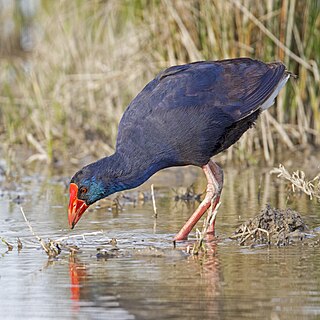
The western swamphen is a swamphen in the rail family Rallidae, one of the six species of purple swamphen. From the French name talève sultane, it is also known as the sultana bird. This chicken-sized bird, with its large feet, bright plumage and red bill and frontal shield is easily recognisable in its native range. It used to be considered the nominate subspecies of the purple swamphen, but is now recognised as a separate species. The western swamphen is found in wetlands in Spain, Portugal, southeastern France, Italy and northwestern Africa.

Allen's gallinule, formerly known as the lesser gallinule, is a small waterbird of the family Rallidae. Its former binomial name is Porphyrula alleni. Porphyrio is the Latin for "swamphen", and alleni, like the English name, commemorates British naval officer Rear-Admiral William Allen (1792–1864).

This article is on the New-World purple gallinule, not the Old-World purple gallinule, which is the western swamphen.

Demetri Porphyrios is a Greek architect and author who practices architecture in London as principal of the firm Porphyrios Associates. In addition to practice and writing, Porphyrios has held a number of teaching positions in the United States, the United Kingdom and Greece. He is currently a visiting professor at the Yale School of Architecture.

Porphyrio is the swamphen or swamp hen bird genus in the rail family. It includes some smaller species which are usually called "purple gallinules", and which are sometimes separated as genus Porphyrula or united with the gallinules proper in Gallinula. The Porphyrio gallinules are distributed in the warmer regions of the world. The group probably originated in Africa in the Middle Miocene, before spreading across the world in waves from the Late Miocene to Pleistocene.

Glenealy is one of the few roads or streets without a suffix in Hong Kong. Located in the Mid-levels on the Hong Kong Island, Hong Kong, it starts from Ice House Street and goes uphill to Hong Kong Zoological and Botanical Gardens, across Robinson Road and ends at Hornsey Road and Conduit Road.

The North Island takahē or mōho is an extinct rail that was found in the North Island of New Zealand. This flightless species is known from subfossils from a number of archeological sites and from one possible 1894 record. It appeared to have been even larger than the South Island takahē and, if it did survive until the 1890s, would have been the largest rail in historic times. The decline of the species has generally been attributed to the increasing incursion of forest into the alpine grasslands through the Holocene, although hunting by the Māori also played a major role.

Glenealy is a village 8 km (5.0 mi) west of Wicklow Town, in County Wicklow, on the R752. The Dublin - Rosslare railway line also passes through the village.

Saint Porphyrios (Bairaktaris) the Kapsokalyvite was an Athonite hieromonk known for his gifts of spiritual discernment, a type of clairvoyance which he sometimes called "spiritual television."

The Australasian swamphen is a species of swamphen (Porphyrio) occurring in eastern Indonesia, Papua New Guinea, Australia and New Zealand. In New Zealand, it is known as the pukeko. The species used to be considered a subspecies of the purple swamphen.

The Driehaus Architecture Prize, fully named The Richard H. Driehaus Prize at the University of Notre Dame, is a global award to honor a major contributor in the field of contemporary vernacular and classical architecture. The Driehaus Prize was conceived as an alternative to the predominantly modernist Pritzker Prize.

Glenealy Hurling Club is a Gaelic Athletic Association club located in the parish of Glenealy and Ashford in County Wicklow, Ireland. The club was founded in 1885 as a football club but switched codes to the game of hurling in the early 1920s.

Grey-headed swamphen is a species of swamphen occurring from the Middle East and the Indian subcontinent to southern China and northern Thailand. It used to be considered a subspecies of the purple swamphen, but was elevated to full species status in 2015; today the purple swamphen is considered a superspecies and each of its six races are designated full species.

The African swamphen is a species of swamphen occurring in Egypt, Sub-Saharan Africa and Madagascar. It used to be considered a subspecies of the purple swamphen, which it resembles, but with bronze green or green-blue back and scapulars.

Glenea spinifera is a species of longhorn beetles belonging to the family Cerambycidae, subfamily Lamiinae.

Glenea is a genus of longhorn beetles belonging to the family Cerambycidae, subfamily Lamiinae.

The black-backed swamphen is a species of swamphen occurring from southeast Asia to Sulawesi and Borneo. It used to be considered a subspecies of the purple swamphen, which it resembles, but has a large shield, black upperparts, and the side of the head is blackish.
The purple swamphen has been split into the following species:
Glenea lineata is a species of beetle in the family Cerambycidae. It was described by Charles Joseph Gahan in 1897.















